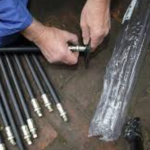We all want to save money on air conditioning and one of the best ways to do that is to perform routine maintenance on your HVAC system. One of the areas that needs particular attention is the air conditioning unit’s drain line.
What’s that, you’ve never heard of the drain line? Well you better get acquainted with it quickly or you could be facing serious issues not just with your unit but with the home as well. As you may have guessed by now, the drain line (and the drain pan) are both instrumental in moving condensate from your air conditioner and your home to the outdoors.
When those routes become clogged, it can result in the moisture getting backed up and spilling into the house, causing water damage and the growth of mold.
The drain itself can become clogged for any number of reasons including bacterial build-up, mold and algae growth, and the result is a drain that isn’t working properly. Not only will it cause spill over in the home, but you may detect bad odors and increased humidity in the system. Both of these can impact your home in ways that equal dollar signs later on.
How it Works

So how does that cold air come out of your HVAC system and why is water involved? It all starts with the evaporator coil which produces cold air from warm air that is introduced into the system. When the coil converts the warm air to cold, condensation occurs.
That moisture needs somewhere to go as it will begin to pool up quickly and so the drain line and drain pan are installed to move the water out of the system and out of the home.
But in order for the condensate to escape, the drain line has to be open. Most of them are constructed from standard PVC pipe and the water is designed to pour through it. But when the line is clogged, the water can get backed up like it would in a clogged sink. If that occurs, the water does not go out the drain pipe but spills other directions into your home.
So it’s imperative that you check the drain line and the drain pan, which should be replaced every 10 to 15 years as these pans can start to deteriorate and leak. Checking the drain keeps your HVAC system working correctly and prevents damage to your air conditioning unit and the walls, floors, and ceilings of your house.
What to Do

Luckily, you can fix this problem before it becomes a serious matter. All you need to do is locate the drain pan first and take a look at the condition it’s in.
First things first, turn off your HVAC system. Make sure all the power has been interrupted. If you don’t, you could be risking injury.
Next, go find the drain. Depending on your system, this could be located in a number of possible areas. You can check your owner’s manual for the panel that is concealing your drain pan. It may be under your unit as well.
Once you find the pan, you’ll notice whether or not the drain is clogged almost immediately as there will be water standing in the pan. Before you can get to work removing the clog, you need to first remove the standing water.
Depending on how much water is sitting there, you may need to suck it up with a wet-dry vacuum in order to get most of it from the pan. If you don’t have one of those, start scooping it out with a bucket or some other container.
Once you’ve removed most of the water, soak up the remaining moisture with a towel or rag. Now you can get a look inside the drain. Grab that vacuum again and try to apply suction to the drain opening in order to remove whatever’s clogging it up.
If you don’t have the vacuum, then you need to get in there with your hand, see if you can remove it manually. Short of that, you may need to pour in some distilled vinegar to flush the drain clean. You may also try peroxide or hot water and dishwashing soap. One or all of these may be required to flush the drain clear.
Allow whatever you’ve poured inside to remain in there for about 30-45 minutes. Once that time has passed flush the drain with water. You can tell if the clog is eliminated by checking the outdoor pipe to see if the water is exiting properly.
If all else fails, call one of our experts at river city heating and air to have the drain professionally cleaned so your HVAC system can run smoothly once again.









